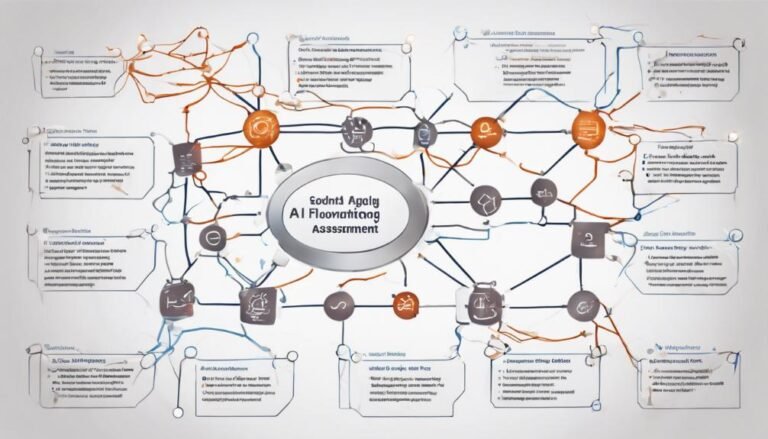AI in Transaction Monitoring
As you explore the domain of transaction monitoring, the integration of Artificial Intelligence (AI) stands out as a game-changer, revolutionizing the way financial institutions combat fraud. But, have you considered the potential ethical implications that might arise from AI's increasing role in monitoring transactions?
Key Takeaways
- AI analyzes vast transaction data in real-time for fraud detection.
- Machine learning enhances pattern recognition for accurate anomaly detection.
- AI automates flagging potential fraudulent transactions based on rules and anomalies.
- AI streamlines compliance by promptly detecting suspicious activities.
- Ethical, transparent, and regulatory considerations shape the future of AI monitoring.
Evolution of Transaction Monitoring
Analyzing the historical progression of transaction monitoring reveals a series of significant advancements in technology and regulatory requirements. From a historical perspective, transaction monitoring has evolved hand in hand with technological advancements.
Initially, manual reviews of transactions were the norm, relying on human intervention to detect potential fraudulent activities. As technology progressed, rule-based systems were introduced, allowing for the automation of certain monitoring processes based on predefined criteria.
Over time, the evolution of transaction monitoring has seen the integration of machine learning algorithms and big data analytics to enhance detection capabilities. These technological advancements have enabled more sophisticated monitoring systems capable of analyzing vast amounts of data in real-time to identify suspicious patterns and anomalies. Additionally, the introduction of blockchain technology has added a new layer of security and transparency to transaction monitoring processes.
In parallel, regulatory requirements have also played an important role in shaping the evolution of transaction monitoring systems, necessitating constant innovation to comply with stringent guidelines and standards. The synergy between historical advancements in technology and regulatory demands has propelled transaction monitoring to its current state of sophistication and effectiveness.
Role of AI in Fraud Detection
The integration of artificial intelligence (AI) in fraud detection has revolutionized the efficiency and accuracy of monitoring systems. AI algorithms can analyze vast amounts of data in real-time, enabling proactive identification of suspicious activities. In fraud detection, AI plays a vital role in risk analysis by continuously learning from new data patterns and adapting its detection capabilities. This dynamic approach allows AI to stay ahead of evolving fraud tactics, providing a proactive defense mechanism.
Moreover, AI enhances data accuracy by automating the process of flagging potential fraudulent transactions based on predefined rules and anomaly detection. By cross-referencing various data points and conducting complex pattern recognition, AI drastically reduces false positives and false negatives, thereby improving the overall effectiveness of fraud detection systems.
Enhancing Compliance With AI
To further optimize financial monitoring systems, consider how AI can enhance compliance efforts within transaction monitoring processes. Regulatory challenges in the financial sector require robust compliance mechanisms. AI offers the capability to streamline compliance by automating the detection of suspicious activities, ensuring adherence to regulations and minimizing risks.
Industry applications of AI in enhancing compliance are vast. AI algorithms can analyze vast amounts of transactional data in real-time, flagging potential compliance breaches promptly. By implementing AI, financial institutions can improve their monitoring processes, reducing manual errors and increasing efficiency. Additionally, AI can adapt to evolving regulatory requirements, staying up-to-date with changing compliance standards.
Moreover, AI can enhance the accuracy of compliance reporting, providing detailed insights into transactions and activities that may raise red flags. This level of precision is essential in meeting compliance obligations and mitigating risks associated with non-compliance.
Benefits of Machine Learning Technology
Machine learning technology offers significant advantages in enhancing the efficiency and effectiveness of transaction monitoring processes in the financial sector. By utilizing advanced algorithms, machine learning enables automated data analysis to identify complex patterns that may indicate suspicious activities. This technology can quickly process vast amounts of transaction data, flagging anomalies for further investigation with a high degree of certainty.
One key benefit of machine learning in transaction monitoring is its ability to adapt and improve over time. Through continuous exposure to new data, machine learning models can enhance their pattern recognition capabilities, becoming more adept at detecting unusual behaviors and evolving financial crime tactics. This adaptive nature guarantees that the monitoring system remains robust and effective in combating fraudulent activities.
Furthermore, machine learning technology streamlines the monitoring process by reducing false positives, allowing financial institutions to focus their resources on genuine threats. By automatically learning from historical data and adjusting its algorithms, machine learning enhances the overall efficiency and accuracy of transaction monitoring systems, making them indispensable tools in the fight against financial crime.
Future Trends in AI Monitoring
Utilizing advanced artificial intelligence algorithms holds the key to unlocking future advancements in transaction monitoring capabilities. As AI continues to evolve, future trends in AI monitoring will be shaped by addressing ethical implications and regulatory challenges.
Ethical implications play an essential role in the development and deployment of AI monitoring systems. Ensuring that AI algorithms are designed and utilized ethically is paramount to maintaining trust and integrity in the monitoring process. Transparency, fairness, and accountability are key considerations in the development of AI systems for transaction monitoring.
Moreover, regulatory challenges pose a significant hurdle that must be addressed in the future of AI monitoring. Compliance with various regulations and standards is crucial to guarantee that AI monitoring systems operate within legal boundaries and meet industry requirements.
Striking a balance between innovation and regulatory compliance will be key to driving the future of AI monitoring technology while upholding ethical standards and addressing regulatory challenges head-on.
Conclusion
To sum up, AI has revolutionized transaction monitoring by efficiently detecting fraudulent activities and ensuring compliance with regulations.
But how can financial institutions maximize the potential of AI to stay ahead of constantly evolving fraud tactics?
The answer lies in continuous improvement and integration of cutting-edge AI technologies to enhance risk analysis and protect against financial crimes.
Embracing AI is the key to staying one step ahead in the ever-changing landscape of transaction monitoring.







